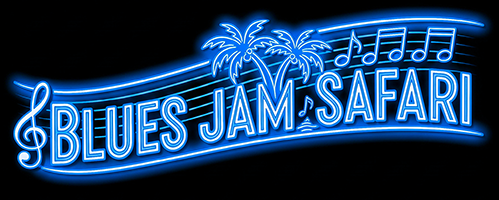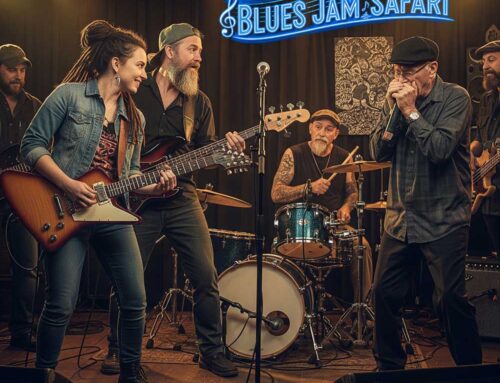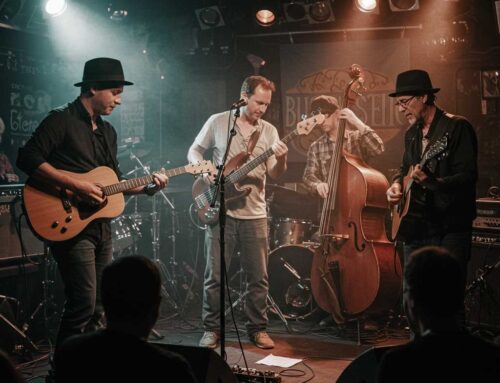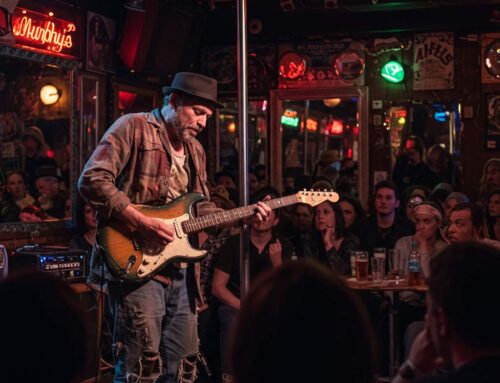A Guide to the Many Types of Blues Jams
By: Richard Harvey
Blues jams. The very phrase conjures images of smoky rooms, wailing guitars, and raw, unadulterated music. But if you think every blues jam is the same, you’re missing out on a rich tapestry of formats and environments. From highly structured sessions to spontaneous combustion, and from intimate dive bars to captive audiences, the world of blues jams is as diverse and soulful as the music itself.
We’ve talked before about the unwritten rules – listening, playing with feel, watching the bass player, and knowing when to end your solo. These are the threads that tie all jams together. But the type of jam and the venue it calls home fundamentally shape the experience for both musicians and patrons.
The Many Flavors of the Blues Jam
Not all jams are created equal. They vary widely in their formality, focus, and the kind of energy they foster.
- The Classic Structured Jam
- Format: This is the most common and organized type. It almost always features a dedicated house band that plays the backbone of each song. As seen in “The Sign-Up Sheet” format, musicians are called up in rotation, usually for 1-3 songs or solo spots.
- Vibe: Orderly, inclusive, great for newer players to get their feet wet in a supportive environment, and for seasoned players to enjoy seamless transitions.
- Expect: Clean changes, clear communication from the house band, and a steady flow of different musicians.
- The Loose / Informal Jam
- Format: Less formal, often aligning with a “No List” approach. Musicians might just walk up, make eye contact with the house band (or even just another musician who knows them), and jump in. Often, it’s more about extended improvisation or a few core musicians really stretching out.
- Vibe: Organic, raw, unpredictable, sometimes chaotic but can lead to moments of pure, unbridled musical magic. Best for experienced players who can adapt on the fly.
- Expect: Less structure, more extended solos, and a heavier reliance on non-verbal cues and intuition.
- The Invitational Jam
- Format: Often led by one or more highly respected, often touring, professional blues musicians. While still open to others, the standard of playing is expected to be very high. Guest musicians might be vetted or known to the host.
- Vibe: Inspirational, aspirational, musically advanced. It’s a chance to play with (or just witness) true masters. Sometimes less forgiving of less experienced players.
- Expect: Exceptional musicianship, complex arrangements (even improvised), and a generally more serious musical atmosphere.
Jam Management Styles: Chaos vs. Cohesion
Beyond merely having a sign-up list, how the host band manages the rotation of guest musicians profoundly impacts the quality of the show.
- First on the List, First Up
- How it Works: This strict adherence to the sign-up sheet means that whoever’s name is next gets to play, regardless of their experience level, instrument, or how they might fit with the current players.
- Pros: Absolutely fair, democratic.
- Cons: Can lead to unpredictable and often weak shows. A novice player might follow a master, or instruments might clash. This format can result in “train wrecks” and musical chaos, as there’s no curation of talent or flow. The audience’s experience can suffer greatly.
- Why it’s Permitted in Destination Venues: Because Destination Venues have a captive audience with nowhere else to go, they can (and often do) get away with this less curated approach. Patrons are stuck there and will likely stick around even if the show quality dips, leading to a less satisfying experience for them in the long run.
- Rotating Jammers with the Host Band
- How it Works: The host band, or a dedicated jam leader, takes an active role in deciding which guest musicians play when. They’ll look at the sign-up list but may strategically call up players based on:
- Instrumentation: Ensuring a balanced band (e.g., not three harmonica players at once).
- Experience Level: Mixing seasoned pros with newer players to create a supportive, yet high-quality, sound. This often means putting the best players on in prime time and scheduling beginners or less gifted players later in the evening when the crowd might be smaller or more relaxed.
- Genre Fit: If it’s a specialty jam, ensuring players fit the theme.
- Flow and Dynamics: Planning transitions to maintain energy and musical interest.
- Pros: Always provides for a better, more cohesive show. The music flows more seamlessly, the quality remains higher, and the audience has a consistently enjoyable experience. It’s all about putting on the best possible show.
- Cons: Can sometimes feel less “fair” if a player has to wait longer or is skipped, though a good host will manage expectations.
- Why it’s Essential in Music/Night Club Districts: Music/Night Club District venues must put on the best possible show. They risk losing their crowd if the music isn’t excellent, as patrons can easily walk out and find another club. This competitive environment necessitates a curated approach to jam management.
- How it Works: The host band, or a dedicated jam leader, takes an active role in deciding which guest musicians play when. They’ll look at the sign-up list but may strategically call up players based on:
Sign-Up List vs. No List: Navigating Your Turn
The presence or absence of a sign-up sheet significantly impacts how musicians get their chance to play and the overall dynamic of the jam. This is a fundamental aspect of how any jam operates.
- The “Sign-Up Sheet” Jam
- How it Works: Upon arrival, musicians locate a physical sheet (often near the stage, sound engineer, or bar) where they write their name and instrument(s). The house band or host calls names in order, ensuring a structured rotation.
- Pros: Fair and predictable. Ensures everyone gets a turn and prevents a chaotic scramble for the stage. Great for all levels, as the waiting time allows for observation.
- Cons: Can be slow-moving if there’s a long list, requiring patience. Less spontaneous jump-ins.
- Musician’s Strategy: Sign up clearly. Stay near the stage and be ready when your name is called. Respect the order. Don’t monopolize the list.
- The “No List” Jam
- How it Works: There’s no formal list. Access to the stage is determined by observation, non-verbal cues, and polite communication with the jam host or house band leader. It’s about reading the room and finding an opening.
- Pros: Highly spontaneous and fluid. Can lead to extended, organic improvisations if the chemistry is right. Feels more informal and “in the moment.”
- Cons: Can be intimidating for new or less assertive players. Might be harder to get a turn if you’re not known or if the jam is already very active. Can occasionally lead to awkward “stage hogging.”
- Musician’s Strategy:
- Observe: Watch how others get on stage. Who seems to be managing the flow?
- Introduce Yourself: During a break, politely approach the host/bandleader, introduce yourself and your instrument, and express your interest in sitting in.
- Signal Readiness Subtly: Once you’ve made contact, standing near the stage with your instrument ready (but not blocking anyone) can signal your readiness. Make eye contact with the leader when they look for the next player.
- Be Patient and Respectful: Never just jump on stage uninvited. Your patience and social grace are key here.
The Venue: Shaping the Jam Experience
The physical location of a blues jam has a profound impact on its atmosphere, the audience’s engagement, and the musicians’ pressure to perform.
- The Destination Venue
- Description: These are music clubs or venues that are isolated within a city, town, or county, meaning there are no other readily available music entertainment options nearby. Patrons who choose to attend have committed to being there for an extended period, and the jam is a primary form of evening entertainment.
- Pros:
- Captive Audience: Patrons are “trapped” (in the best possible way!) for the evening. They’ve paid to be there and are invested in the experience. This means they’re often more attentive and appreciative.
- Immersive Experience: The venue itself often contributes to the overall theme, creating a truly immersive musical journey.
- Cons: The audience has nowhere else to go, meaning they are likely to stick around even if the jam isn’t stellar, which can lead to a less satisfying experience for patrons who are there for the long run.
- The Music/Night Club District
- Description: Located in bustling urban entertainment districts, where multiple music clubs, bars, and restaurants are within easy walking distance. Patrons are often hopping between venues.
- Pros:
- High Competition, High Quality: The unspoken understanding is that if the show “stinks,” patrons can (and will) walk out and find another club with better music. This fosters a competitive environment that often drives musicians to deliver top-notch performances.
- Diverse Options: For patrons, it’s a buffet of live music. They can sample different bands and jams.
- Dynamic Atmosphere: The energy of a thriving music district can be infectious, with crowds spilling out onto the streets, adding to the vibrancy.
- Cons: Short attention Tensions; musicians need to capture and hold interest immediately. Less loyalty if the quality dips.
- Local Dive Bars / Community Centers
- Description: Often smaller, more intimate, and deeply embedded in a local community. These are your classic “local watering hole” jams.
- Pros:
- Authenticity & Roots: These often feel like the most genuine blues jam experiences, with a strong sense of tradition and community.
- Supportive Environment: Regular patrons and musicians often form close bonds, creating a very encouraging atmosphere for all players, especially beginners.
- Lower Pressure: Less about “making it big” and more about the sheer love of playing and connecting.
- Cons: Less exposure for musicians, smaller crowds, and sometimes less polished sound systems.
Why Understanding This Matters
For musicians, knowing the jam format and venue type helps you prepare, adapt your playing, and manage your expectations. For patrons, it informs where to go for the specific kind of blues jam experience they’re seeking – whether it’s a focused, high-stakes performance or a loose, communal gathering.
No matter the format or the venue, the core spirit of the blues jam remains: a dedication to an enduring American art form, brought to life through the spontaneous, heartfelt collaboration of musicians. It’s a world where every night is a unique story, waiting to be played.
Conclusion
In our view, the ideal blues jam experience, for both musicians and audience, is achieved through a combination of thoughtful management and respect for the show. While all jams offer unique charm, the most consistently high-quality performances often arise from a system that utilizes a sign-up list in conjunction with a “Rotating Jammers with the Host Band” approach. By strategically putting the most seasoned and engaging players on stage during prime time, an established host band can maintain momentum, ensure musical cohesion, and deliver a consistently excellent show that celebrates the very best of spontaneous blues. This ensures that the raw energy of the jam is always channeled into an unforgettable performance.






